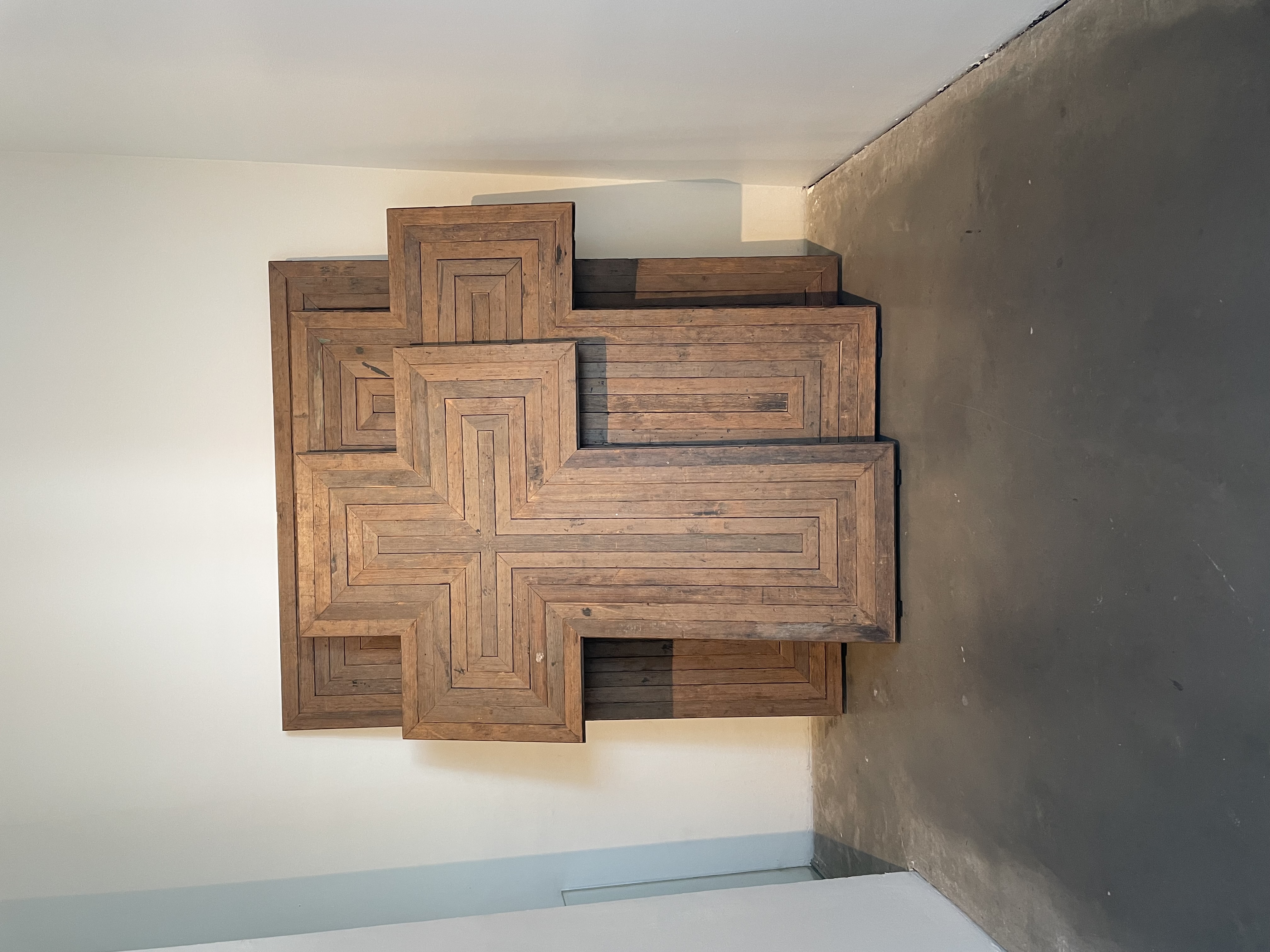Presence Is Grace
Theaster Gates at the New Museum
November 10, 2022 – February 5, 2023
“Young Lords and Their Traces” is a Trojan horse, maybe one of the most well built you have ever gotten to see. Beautiful things like clay sculptures, monochromes, 19th-century vitrines, Stella’s deductive structures, fathers and mothers are assembled over three floors to mourn the “loss of spiritual spaces” in the United States of America, as the wall label for St. Laurence Bell (2014–22) finally admits on the last floor. But loss, or better, absence, is but the starting point of the exhibition: Circle Form With Pier (2019) is a semi-circular clothing rack made of steel and bronze, based in a hexagon-shaped concrete pier, a white fur coat and hat, by the wall label identified to be property of the artist’s father. Loss and absence refer to several things here: The sculpture’s concrete base as reminiscence of the fractured utopianism of Brutalist architecture, the rusty steel patina as reminder of long-gone U.S. manufacturing capacities (further emphasized by the word industrial being engraved onto the heavy wooden hangers), the rabbit fur as a reminder of the last days of disco. But don’t mistake it as an attempt to tell the different episodes of the triumph and fall of the Keynesian consensus. With the coat’s presence rendering his body absent, it is about transmuting the loss of the father into a sculptural unity.

The father figure lies in fact at the center of the exhibition, its meaning slowly shifting. It starts with an abundance of references to Gates’s literal father. For instance, the seven beautiful tar paintings of Seven Songs for Black Chapel #1-7Black Chapel (2022), where the transmutation of working-class labor into monochromatic paintings was supposed to break modernism’s self-referentiality by turning it into a springboard for a return to faith.
Father, in fact, doesn’t just refer to the head of the family unit, as the wall labels struggle to emphasize in their uphill battle against the exhibition’s evidence. For instance, in Art Histories (2019) we are not only confronted with an idiosyncratic selection of the 60,000 art historical slides that Gates acquired from the University of Chicago, here repurposed to build the foundation for a new (more plural?) discipline. More importantly, two large wooden benches from a church are placed at the center of the room. That we are indeed being addressed as a congregation becomes clearest when one of the six channels suddenly switches from Egyptian pottery to a lecture by Fred Moten who speaks with his deep signature voice from a wooden pulpit down to us. Yes, we can find our way again, not by being iconoclasts but by listening again. Yes, we are here to receive the message.
Only, whose message is it really? On the second floor, a vast array of sculptures is assembled that mimic forms that you will find at the MET’s Mesopotamian, Egyptian, and East Asian wings, many of which predate Christ by thousands of years. Similarly, the video Billy Sings Amazing Grace (2013) stages the collaboration between African American vernacular traditions and East Asian monastic customs, gesturing at a spirituality across religious boundaries. But really this is more about Christianizing the world than about worldening Christianity. Quantity is one of the indicators here, with crosses appearing wherever you look (I counted 24, but there might be more) and in many disguises (the best one is probably a Patriarchal cross from the 10th century). In fact, crosses are even discovered in objects that were explicitly non-Christian, like the militant secularism of Stella’s Black Paintings turned in Gates’s Cross in Sections (2022) and Double Cross (2022) into matters of faith: Water becomes wine, bread becomes body.
What’s art got to do with it? After slowly making our way up, the last floor offers the key. An organ sits at the center, waiting to be played every Saturday from 1 to 4 p.m. by musician Shedrick Mitchell with his “roots deeply planted in Gospel/Christian music.” And while being immersed in the jazzy Christian organ concert, Stella’s deductive structures turned Christian symbols hover above us. Just like in Rothko’s late modernist chapel, art is employed to resanctify the White Cube: transcendence for the atomized and alienated cosmopolitan urban dweller. But really it is St. Laurence Bell that drives the point home: Saved from the destruction of its former home, a Catholic church in Chicago’s South Side, it is tucked away in a corner, placed inside a shack made of corrugated sheets. Danh Võ’s 08:43, 26.05 (2009) might come to mind here, the chandelier hovering above the Paris Peace Accords that Võ famously disassembled to refract a historical index onto itself. But Gates’s employment of the spiritual residue of the working-class community is not so much about turning it into a museum artifact awaiting dissection as it is part of a proper upcycling process: Granted a second chance, it is in its new home that the bell may bring faith to the unfaithful. This is no longer a chapel, this is a cathedral.